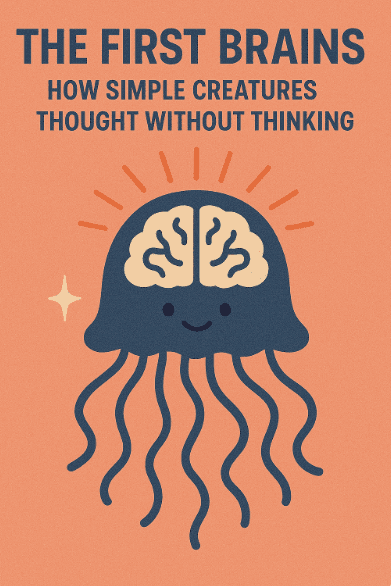
In Topic 1, we explored the brain itself—its parts, its protective armor, and the tiny cells inside it called neurons and glia. We learned that neurons send messages with electricity and chemicals, like little sparks and whispers. We also saw that the brain is shielded by the skull, membranes, and secret fluids, all working together like a castle protecting its king.
Now we’re going to time-travel, not with a machine, but with knowledge. We’re traveling backward—millions and even billions of years into the past—to meet the very first creatures that had something like a brain.
Life Before Brains 🐚
Imagine a world long before humans, dinosaurs, or even fish. We are talking about over 600 million years ago, when life was mostly in the oceans. The creatures here were simple—like sponges, jellyfish, and worms.
Some of these earliest animals didn’t even have brains.
A sponge, for example, doesn’t think at all. It just sits in the water, filtering tiny bits of food. But then something amazing happened.
Some creatures developed special cells that could sense the environment—like light, touch, or chemicals—and tell their body how to react.
This was the very beginning of the nervous system.
What Is a Nervous System?
A nervous system is a set of special cells that carry messages around the body. Think of it like a city with telephone wires, sending signals from one place to another. Without it, a creature can’t really react quickly.
For example:
-
A sponge has no nervous system. It cannot move away if something touches it.
-
A jellyfish has a simple “nerve net”—a web of nerve cells that let it move its tentacles and sting prey.
-
Worms developed nerve cords, like simple highways of information running through their bodies.
So, the nervous system came before brains. First, animals just needed a way to sense and move. Only later did those nerve cells gather into something like a control center—the very first brains.
Reflexes Before Thinking ⚡
Here’s the big idea: the first creatures with nerves didn’t really think. They reacted.
For example, picture a worm in water. If something touches its skin, the worm instantly wriggles away. It doesn’t stop to consider: “Hmm, should I move or not?” Instead, its nerves send a reflex—an automatic reaction.
Even humans have reflexes like this today. If you accidentally touch a hot pan, your hand pulls back before you even “decide” to move it. This ancient wiring is proof that our nervous system is older than thought itself.
So, before there were “brains” that could imagine, plan, or dream, there were just reflexes. Reflexes were enough to help creatures survive in dangerous oceans full of predators.
From Reflex Nets to Mini Brains 🧩
As time passed, some creatures became more complicated. Jellyfish, worms, and starfish show us three different stages of early nervous systems:
-
Jellyfish nerve nets – Like a spider web, with signals moving in all directions. No central brain.
-
Worm nerve cords – A straight line of communication, with little clusters of neurons called ganglia (tiny control centers) along the way.
-
Early arthropods (insects, crabs) – They developed bigger ganglia that worked like mini-brains, controlling movement, vision, and behavior.
These ganglia were the stepping stones toward real brains. Over millions of years, the biggest ganglion (in the “head” region) became the main boss of the nervous system—what we now call a brain.
Why Did Brains Evolve? 🤔
Let’s ask the big question: why did creatures even need brains? Why not just stay with reflexes?
The answer is survival. Reflexes are great for quick reactions, but they are not enough when:
-
The world becomes more complex.
-
Animals need to find food in smarter ways.
-
Creatures must remember danger and avoid it next time.
Imagine two early animals:
-
One reacts only to what touches it (reflex only).
-
Another can remember that a certain smell means food is nearby (basic brain power).
Which animal survives better? The one that can learn and remember. That’s why brains evolved—they gave animals the ability to adapt and survive in a changing world.
A Day in the Life of a Worm 🪱
Let’s bring it to life with a story.
Imagine you are a worm 500 million years ago. You live in the ocean mud. You can sense when something brushes against you. Your tiny ganglia send signals down your body, and you wriggle fast. If you wriggle away, you survive another day. If not—you become someone else’s lunch.
Now imagine a cousin worm who has a little more developed nervous system. Not only can it wriggle, but it can also sense light above and stay hidden in the mud during the day. That cousin has a much higher chance of surviving—and passing on its genes.
Over millions of years, little improvements like this gave rise to creatures with bigger nervous systems and, eventually, real brains.
From Worms to Fish 🐟
The first animals with actual brains appeared in early fish. These brains were small but had distinct parts—one for sensing smells, one for sight, one for movement. With brains, fish could:
-
Hunt prey more effectively.
-
Avoid predators more cleverly.
-
Explore new environments.
This was the dawn of thinking creatures. It wasn’t human-level thinking, but it was more than reflex. It was the ability to make choices based on memory and senses.
Key Takeaways 🌟
-
The nervous system evolved before brains.
-
The earliest animals (sponges, jellyfish, worms) show us different stages.
-
Reflexes came first; thought came later.
-
Brains evolved because they gave survival advantages—allowing learning, memory, and smarter behavior.